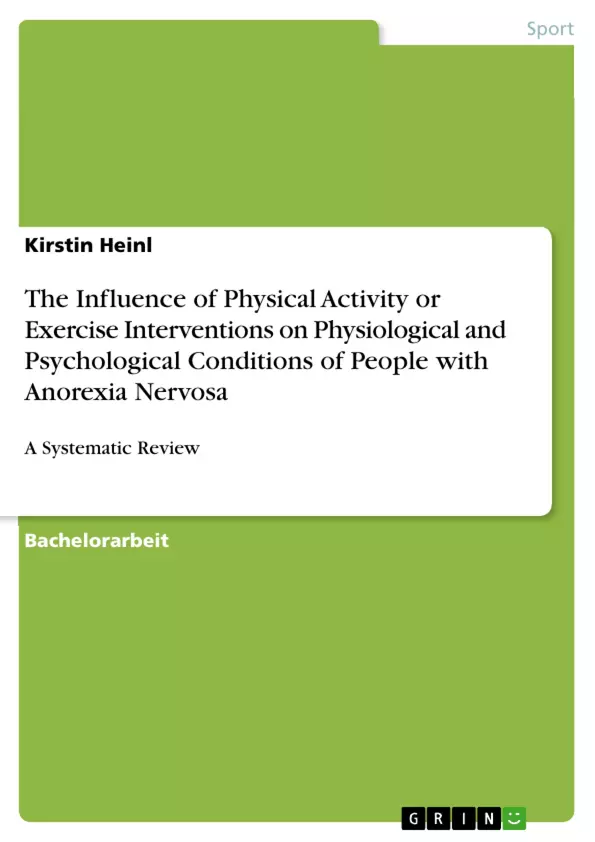Theoretical Background: Patients with Anorexia Nervosa (AN) often practice physical activity to influence their weight and shape or they partake in sporting exercise in a compulsive manner. It is generally known that physical activity may have negative consequences for patients with AN, if it is conducted excessively or used as a method to control weight. Otherwise, sport can be used as a therapy to find a way to mitigate the medical condition or even cure it by influencing physiological and psychological condition of the patient and improving their fitness and self-esteem.
The primary objective is to find out if and to what extent sports-therapy or physical activity can have a positive influence on sufferers of an Eating Disorder (ED). This elaboration is a systematic review that summarizes studies, which show the effect of physical activity in correlation with Anorexia Nervosa (AN). To give the reader an overview of the topic of ED, it is essential to clarify the causes of AN, its risk factors, as well as the consequences for the patient’ health that result from it. Method: Use of comparable studies, taken from the medical meta-database PubMed that analyzed a range of nonathletic adolescents, who were diagnosed with AN and underwent a schedule of low-intensity physical activity for a limited period. Target group: This thesis sets out to summarize the results of existing studies on this topic. Its objective is to prove any coherence in the results of these studies, and as a consequence proved information to therapists, or patients, suffering from AN, if and which kind of physical interventions could have a positive or negative influence on the ED. Results: Overall, seven studies were found that met the inclusion criteria.
The results prove that only two of these studies show a significant improvement in physical conditions compared to the control group, while five of them reported better psychological condition. In summary, all participants identified small improvements, and none of the studies showed indications of deterioration. Conclusion: Given the suitable intensity and extensive duration of the therapy program, physical intervention in the form of anaerobic or resistance training can possibly lead to beneficial and significant outcomes in physiological strength, fitness and the psychological well-being in anorexic outpatients.
Inhaltsverzeichnis
- Abstract
- Table of Contents
- List of Figures
- Table Directory
- List of Abbreviations
- Introduction
- Theoretical Background
- Inclusion Criteria
- Material and Methods
- Search Strategy
- Description of the Included Studies
- Exclusion Criteria
- Study Selection
- Results
- Cohort and Intervention Characteristics
- Outcome Measurement
- Physical Health Outcomes
- Mental Health Outcomes
- Discussion
- General Overview
- Limitations in the Studies
- Future
- References
Zielsetzung und Themenschwerpunkte
Die vorliegende Abschlussarbeit untersucht den Einfluss von körperlicher Aktivität oder Trainingsinterventionen auf die physiologischen und psychologischen Zustände von Menschen mit Anorexia Nervosa. Der Schwerpunkt liegt dabei auf der Frage, ob und inwieweit Sporttherapie oder körperliche Aktivität positive Auswirkungen auf die Betroffenen haben können.
- Ursachen, Risikofaktoren und Folgen von Anorexia Nervosa
- Einfluss von körperlicher Aktivität auf die physiologischen und psychologischen Zustände von Menschen mit Anorexia Nervosa
- Systematische Analyse von Studien zur Wirkung von körperlicher Aktivität bei Anorexia Nervosa
- Bewertung der Studienergebnisse und Ableitung von Schlussfolgerungen für die Therapie
- Zukünftige Forschungsbedarfe in diesem Bereich
Zusammenfassung der Kapitel
- Introduction: Die Einleitung stellt die Relevanz des Themas und den aktuellen Forschungsstand zu Anorexia Nervosa und körperlicher Aktivität dar. Sie beschreibt die Zielsetzung der Arbeit und die Methodik der systematischen Übersichtsarbeit.
- Theoretical Background: Dieses Kapitel beleuchtet die Definition, Ursachen und Folgen von Anorexia Nervosa. Es diskutiert die Rolle von körperlicher Aktivität bei Anorexia Nervosa, sowohl als potenzielles Risiko als auch als mögliche Therapieoption.
- Material and Methods: Dieses Kapitel beschreibt die Suchstrategie und die Auswahl der relevanten Studien, die in die systematische Übersichtsarbeit einbezogen wurden. Es erläutert die Ein- und Ausschlusskriterien für die Studien sowie die Methode der Datenanalyse.
- Results: Die Ergebnisse der Studie werden hier zusammengefasst, wobei die einzelnen Studien hinsichtlich ihrer Methode, ihrer Teilnehmer und ihrer Ergebnisse beschrieben werden. Die Ergebnisse der verschiedenen Studien werden verglichen und analysiert.
- Discussion: Dieses Kapitel diskutiert die Studienergebnisse im Kontext des aktuellen Forschungsstandes und der klinischen Praxis. Es beleuchtet die Stärken und Schwächen der Studien sowie mögliche Limitationen der Ergebnisse. Schließlich werden Empfehlungen für die zukünftige Forschung und die praktische Anwendung der Ergebnisse gegeben.
Schlüsselwörter
Anorexia Nervosa, körperliche Aktivität, Sporttherapie, Trainingsintervention, physiologische und psychologische Zustände, systematische Übersichtsarbeit, Therapie, Gesundheitszustand, Fitness, Selbstwertgefühl, Studienergebnisse, Limitationen, zukünftige Forschung.
- Quote paper
- Kirstin Heinl (Author), 2017, The Influence of Physical Activity or Exercise Interventions on Physiological and Psychological Conditions of People with Anorexia Nervosa, Munich, GRIN Verlag, https://www.grin.com/document/452114



